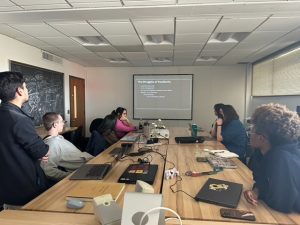The course “Cultural Agency and Human Rights” was not simply a credit or class that I took this semester; it altered my perspective on both art and life itself. Throughout the course I had various realizations that stood out to me, which happened with enough frequency for me to lovingly term them “moments that broke my brain”. From the very structure of the course to the professor, from the material studied to our final papers, this class expanded my horizons with regards to the capabilities of art and human rights.
The structure of the course and the role of the professor as facilitator allowed students to feel as though our thoughts on the material were valuable, in turn fostering an eagerness to understand the topics. The first text assigned, Ranciere’s Politics of the Aesthetics, is to date the most difficult reading I have ever done. My desire to understand the material, combined with the weekly discussion boards where my classmates processed the text in their own words, made it much easier to begin to understand Ranciere’s arguments. Although the course readings never got easier, I grew more excited to read the course material and my classmates’ respective opinions. We all processed information in such different ways that often points that didn’t make sense to me became much clearer when reading my peer’s reflections. Every Thursday, we would be tasked with responding to a peer’s reflection with a “tangent” (new material on the topic discussed, brought in direct response to the peer’s reflections) and explaining it to the rest of the class. In this way, we became “masters” of the texts: each of us challenged ourselves to push our understanding of our peers and the texts to produce new revelations and questions. Professor Falconi balanced lectures with facilitation, resulting in very lively discussions about aesthetics and its role in our lives.

The relationship between myself, my professor, and my peers enhanced the experience of the course. We always had very interesting and sometimes uncomfortable conversations, in which our mutual respect for one another allowed us to feel comfortable sharing our deepest contradictions. The vulnerability that we felt with each other made our interactions more meaningful, with classes often ending with a collective realization from which we would excitedly take down notes.
My final paper, a twelve-page exploration of symbolic reparations and aesthetic theory, truly changed the way I think about the connection between art and human rights. Professor Falconi provided one-on-one mentorship to me throughout the process, recommending readings, podcasts, and distinguished experts to interview in order to understand the nuances of symbolic reparations. I was able to attend an expert-led workshop on symbolic reparations, as well as interview Diego García-Sayán, former president of the Inter-American Court of Human Rights. Through these additional opportunities I gained a stronger appreciation for human rights advancements within Latin America and the Inter-American Court. In my research paper, “The Art of Uncomfortability”, I argued that symbolic reparations serve a unique purpose, and are incomparable to other forms of reparations due to their ability to use aesthetics to preserve victims’ stories and spark dialogue about the future of human rights. When done correctly, symbolic reparations challenge the pre-existing truths of society, working from the understanding that those truths created the conditions for the violations to occur.
Through working on this paper, I have gained resources, understanding, and a stronger urge to incorporate aesthetics into my future human rights advocacy. One lesson I took away from this class is that both art and human rights serve to create uncomfortability, revealing the gaps between where we are and where we want to be as a community. Just as art is a work in process, human rights are forever incomplete. I am incredibly grateful for this course, my peers, and my wonderful professor. I honestly wouldn’t change anything about it.
Breanna Bonner is a rising sophomore double-majoring in Human Rights and Political Science at
UCONN. She plans to pursue a master’s degree in Human Rights before going on to earn her
Juris Doctor Degree. Her research interests include exploring contemporary and historical
attempts at transformative justice, analyzing the role of aesthetic theory and art in human rights
advocacy, and exploring the strengths and limitations of human rights law. Breanna is an
incoming floor mentor for the Human Rights and Actions Learning Community, a mentor and
project supervisor for the Human Rights Close to Home Program, freelance columnist for The
Kansas City Defender, and an incoming Undergraduate Research Fellow for UConn Humanities
Institute (UCHI). You can reach her at breanna.bonner@uconn.edu.